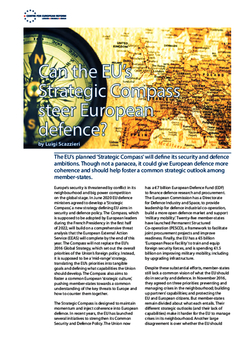
Can the EU's Strategic Compass steer European defence?
The EU’s planned ‘Strategic Compass’ will define its security and defence ambitions. Though not a panacea, it could give European defence more coherence and should help foster a common strategic outlook among member-states.
Europe’s security is threatened by conflict in its neighbourhood and big power competition on the global stage. In June 2020 EU defence ministers agreed to develop a ‘Strategic Compass’, a new strategy defining EU aims in security and defence policy. The Compass, which is supposed to be adopted by European leaders during the French Presidency in the first half of 2022, will build on a comprehensive threat analysis that the European External Action Service (EEAS) will complete by the end of this year. The Compass will not replace the EU’s 2016 Global Strategy, which set out the overall priorities of the Union’s foreign policy. Instead, it is supposed to be a ‘mid-range’ strategy, translating the EU’s priorities into tangible goals and defining what capabilities the Union should develop. The Compass also aims to foster a common European ‘strategic culture’, pushing member-states towards a common understanding of the key threats to Europe and how to counter them together.
The Strategic Compass is designed to maintain momentum and inject coherence into European defence.
The Strategic Compass is designed to maintain momentum and inject coherence into European defence. In recent years, the EU has launched several initiatives to strengthen its Common Security and Defence Policy. The Union now has a €7 billion European Defence Fund (EDF) to finance defence research and procurement. The European Commission has a Directorate for Defence Industry and Space, to provide leadership for defence industrial co-operation, build a more open defence market and support ‘military mobility’. Twenty-five member-states have launched Permanent Structured Co-operation (PESCO), a framework to facilitate joint procurement projects and improve readiness. Finally, the EU has a €5 billion ‘European Peace Facility’ to train and equip foreign security forces, and is spending €1.5 billion on improving military mobility, including by upgrading infrastructure.
Despite these substantial efforts, member-states still lack a common vision of what the EU should do in security and defence. In November 2016, they agreed on three priorities: preventing and managing crises in the neighbourhood; building up partners’ capabilities; and protecting the EU and European citizens. But member-states remain divided about what each entails. Their different strategic outlooks (and their lack of capabilities) make it harder for the EU to manage crises in its neighbourhood. Another large disagreement is over whether the EU should have a role in territorial defence. Most member-states see that as NATO’s task. But Article 42.7 of the Treaty on European Union also commits member-states to assist each other if they come under attack. France wants to use the Compass to flesh out the clause, so that it explains how member-states would respond to an attack. But the debate that France has launched about ‘European strategic autonomy’ has caused tensions with the US and divisions within the EU. Many member-states are wary of upsetting Washington or undermining NATO.
The lack of a coherent common vision and a shared strategic outlook have prevented the member-states from spelling out in detail what capabilities the EU should focus on. This has limited the effectiveness of PESCO and risks limiting that of the EDF. While negotiating the 2021-2027 EU budget, European leaders substantially cut funding for the European Peace Facility (from €10.5 billion to €5 billion), the defence fund (from €13 billion to €7 billion) and military mobility (from €6.5 billion to €1.5 billion). Some PESCO projects are ambitious and useful, for example the Twister programme for a surface-to-air missile. But most projects have not been launched specifically to address identified capability shortfalls, and many are progressing slowly. Efforts to develop common equipment also remain hindered by different arms export policies. Meanwhile, the recession caused by the COVID-19 pandemic is likely to squeeze defence budgets. This makes the success of EU defence co-operation initiatives even more important, as they could blunt the impact of defence cuts.
There is a risk that the Compass will do little to fix the existing issues in European defence. Defining a new strategy is clearly not the same as launching common projects to fill Europe’s well-documented capability shortfalls. Moreover, it will be challenging for member-states to agree on what the main threats to Europe are and how to counter them. To reach consensus, member-states may be tempted to avoid hard questions, or draft an overly ambitious list of what they think the EU should do. There is also a risk that member-states will try to hide disagreements behind ambiguous concepts like ‘strategic autonomy’, without at the same time spelling out what they mean. This would only heighten US concerns that EU defence initiatives undermine NATO, and deter those member-states that care most about US security guarantees from investing in the success of EU defence efforts.
To avoid the risk of the Strategic Compass being an irrelevant exercise, the threat assessment that the EEAS is currently developing should prioritise between the different threats to the EU. On the basis of the threat assessment, the Strategic Compass should focus on fostering further convergence in strategic outlook between member-states and agreement on the priorities for capability development.
The Strategic Compass should focus on fostering further convergence in strategic outlook between member-states and agreement on the priorities for capability development.
Member-states need to tackle some difficult questions. First, they should spell out what tasks they think the EU should focus on and what military capabilities it needs, based on those already identified by NATO’s defence planning process. A sharper definition of goals would then ideally lead to more focus in PESCO projects on filling established capability gaps. Second, member-states should agree on whether the EU should have a role in territorial defence and high-intensity operations that seek to separate warring parties, or whether it should focus on lower-intensity crisis management and areas that NATO does not have great expertise in, such as the protection of civilian infrastructure from cyber attacks. Third, member-states should agree on how the EU’s mutual assistance clause would operate, in case of an attack on a member-state that is not in NATO. Finally, member-states should clarify how the mutual assistance clause would interact with NATO’s Article 5 mutual defence guarantee in the event that a state that is a member of both the EU and NATO is attacked, including through a cyber-attack.
The Strategic Compass cannot be a panacea for European security and defence. EU efforts to become a serious player in security have suffered from a lack of key military capabilities and of political will, and from the fact that NATO remains the bedrock of defence for most member-states. The EU has had multinational ‘Battlegroups’ on standby since 2007, but despite several opportunities to deploy them – such as the 2013 Mali crisis – has never done so.
The Strategic Compass in itself cannot push member-states to invest in filling long-known capability gaps, agree on issues where they sharply differ, or persuade them to invest in making the EU a more capable security and defence actor if they do not want it to be so. But the Strategic Compass can be useful if it succeeds in narrowing differences in threat perception and strategic outlook between member-states, and fosters agreement on a few priority areas for capability development, giving both EU and national defence projects greater coherence.
Luigi Scazzieri is a research fellow at the Centre for European Reform.


Comments